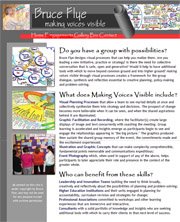Over the last several months I have been experimenting with VUE, free software from Tufts University. Generally, it has been used when we needed a group to identify all the pieces and parts of complex projects. For that kind of work it’s much more versatile than scribing on the wall, and it’s easier to clean up and share than sticky notes. The resolution seems to be really good, although I am getting spoiled to using it on a Smart Board.
Most striking, however, has been the way people engage with it: a s the information begins to accumulate and breed more information, attentiveness to the screen builds. There’s no other practice I’ve used that seems to create that kind of rapt attention and mental processing. Having recently used it on an especially complex and important initiative here in our medical school, I asked two senior leaders who were involved to share their thoughts via a POINt inquiry:
s the information begins to accumulate and breed more information, attentiveness to the screen builds. There’s no other practice I’ve used that seems to create that kind of rapt attention and mental processing. Having recently used it on an especially complex and important initiative here in our medical school, I asked two senior leaders who were involved to share their thoughts via a POINt inquiry:
- The most positive aspects? Could get ideas out quickly, and begin to see myriad interactions and decision issues; “It was kind of fun, too;”
- Opportunities? Good for early stage planning, especially on projects that are at all dynamic in time, or have significant complexities;
- What issues are there? Not linear enough to assure completeness, and too informal to be completely comfortable with its reliability; sometimes ideas flowed faster than the keyboard operator could capture them;
- What new thinking might address the issues? Add another layer of organization - develop a map with the group when it is brainstorming and then ask someone to put the information into a more traditional format with chronological tracking of some kind.
 (Note: this last image is deliberately low resolution as the content does not lend itself to broadcasting.)
(Note: this last image is deliberately low resolution as the content does not lend itself to broadcasting.)


No comments:
Post a Comment